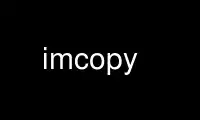
This is the command imcopy that can be run in the OnWorks free hosting provider using one of our multiple free online workstations such as Ubuntu Online, Fedora Online, Windows online emulator or MAC OS online emulator
PROGRAM:
NAME
imcopy - copies FITS images.
SYNOPSIS
imcopy inputImage outputImage[compress]
DESCRIPTION
Copy an input image to an output image, optionally compressing or uncompressing the image
in the process. If the [compress] qualifier is appended to the output file name then the
input image will be compressed using the tile-compressed format. In this format, the
image is divided into rectangular tiles and each tile of pixels is compressed and stored
in a variable-length row of a binary table. If the [compress] qualifier is omitted, and
the input image is in tile-compressed format, then the output image will be uncompressed.
If an extension name or number is appended to the input file name, enclosed in square
brackets, then only that single extension will be copied to the output file. Otherwise,
every extension in the input file will be processed in turn and copied to the output file.
The full syntax of the compression qualifier is:
[compress ALGORITHM TDIM1,TDIM2,...; NOISE_BITS]
where the allowed ALGORITHM values are Rice, GZIP, PLIO, and TDIMn is the size of the
compression tile in each dimension, and NOISE_BITS = 1, 2, 3, or 4 and controls the amount
of noise suppression when compressing floating point images.
Note that it may be necessary to enclose the file names in single quote characters on the
Unix command line.
EXAMPLES
1) imcopy image.fit 'cimage.fit[compress]'
This compresses the input image using the default parameters, i.e., using the Rice
compression algorithm and using row by row tiles.
2) imcopy cimage.fit image2.fit
This uncompress the image created in the first example. image2.fit should be
identical to image.fit if the image has an integer datatype. There will be small
differences in the pixel values if it is a floating point image.
3) imcopy image.fit 'cimage.fit[compress GZIP 100,100;4]'
This compresses the input image using the following parameters:
GZIP compression algorithm; 100 X 100 pixel compression tiles; noise_bits = 4 (only
used with floating point images)
Use imcopy online using onworks.net services
